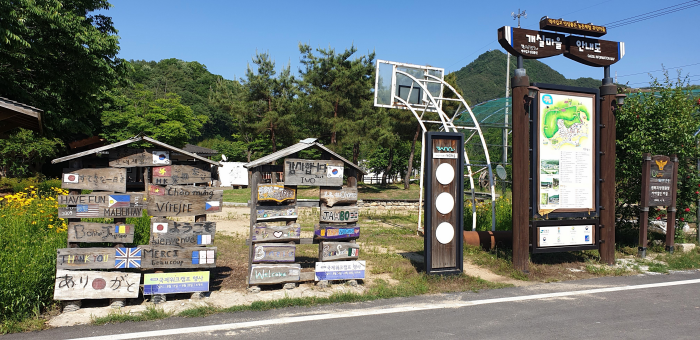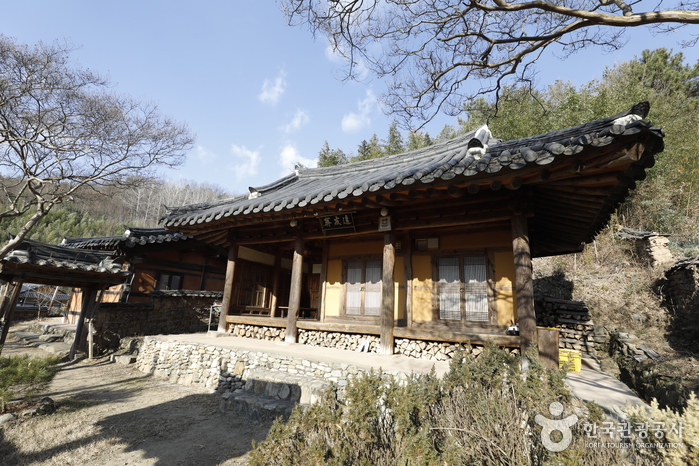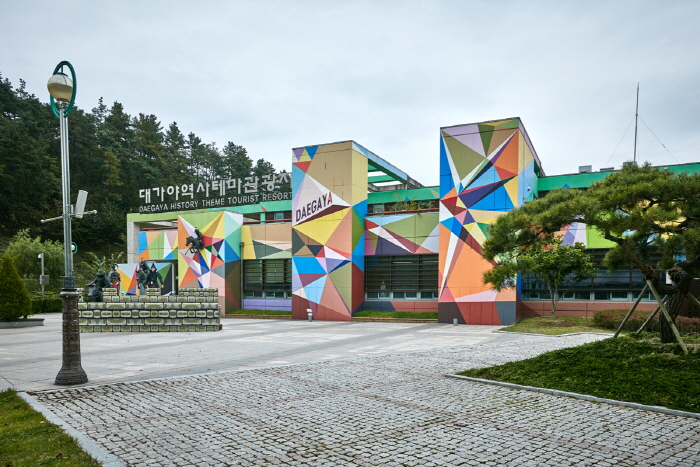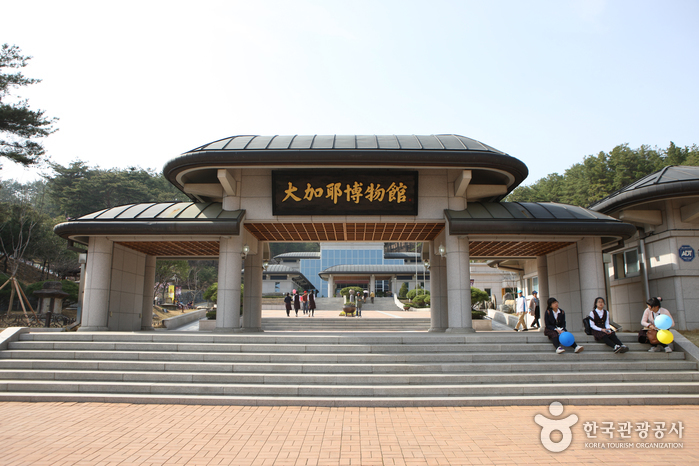Aldea Gaesil (개실마을)
17.1Km 2022-05-10
Gaesil 1-gil 29, Ssangnim-myeon, Goryeong-gun, Gyeongsangbuk-do
La aldea Gaesil está situada en Gyeongsangbuk-do, enfrente del pico Jeopmubong, con forma de mariposa. Hay muchas leyendas sobre protocolo coreano que proceden de este lugar. Una de ellas hace mención a una familia en la que los hijos han apoyado siempre a sus padres durante 5 generaciones. Cuando la madre enfermó, un faisán voló hasta la cocina. En invierno, una carpa saltó del estanque. Por esta leyenda, el pueblo también ha sido llamado "Ingeobaemi". Al contrario que otros pueblos, los descendientes de la aldea Gaesil han mantenido sus tradiciones, como el protocolo y la devoción a los padres, que se puede experimentar durante la estancia en la aldea.
Chuwoojae House / 추우재
17.2Km 2025-08-12
20-1, Gaesil 2-gil, Ssangnim-myeon, Goryeong-gun, Gyeongsangbuk-do
+82-54-956-4022 / +82-10-3207-4022
The village of Gaesil is known as the village of the Seonsan Kim clan. It was established by the descendants of Kim Jong-jik (pen-name: Jeompiljae, 1431-1492), a leading Korean Neo-Confucian scholar and the founder of the Yeongnam Sarim faction during the mid-Joseon period. Boasting over 300 years of tradition, the village is home to sixty households as well as a number of cultural heritages including the head house of Kim Jong-jik (Provincial Folk Material No. 62), Doyeonjae (Provincial Cultural Heritage material No. 111), which is the old village school, and the printing woodblocks for a collection of literary works including Yijonrok (a book about the life and achievements of Kim’s father Kim Suk-ja) written by Kim Jong-jik (Provincial Tangible Cultural Heritage No. 175).
The residents have renovated the village’s earthen walls and hanok houses into a current hanok village, and also run various hands-on experience programs including a hanok stay, a farm product cultivation program, and traditional etiquette and games, thereby offering urban travelers an opportunity to experience a truly rural lifestyle. Chuwoojae House, situated in the heart of the village of Gaesil, has two buildings that are available for rent including the bonchae, which is a single-family house, and the sarangchae, which is a detached building). All guestrooms are equipped with a bathroom and cooking facilities. In particular, the bonchae is heated with a furnace. Guests can use the village public parking lot, but there is also a separate parking lot not far from the house.
Bosque Recreativo del Monte Biseulsan (비슬산자연휴양림)
17.2Km 2023-01-05
Iryeonseonsa-gil 61, Yuga-myeon, Dalseong-gun, Daegu.
El Bosque Recreativo del Monte Biseulsan de Dalseong-gun de Daegu está situado debajo de los picos Johwabong y Daegyeonbong. Se ven formaciones rocosas de la ladera de la montaña, valles con aguas limpias y en primavera se notan las azaleas rosas en los senderos. En invierno, se puede disfrutar de actividades en cuevas y torres de hielo, pistas de trineo, etc. Dentro del Bosque Recreativo se encuentran instalaciones de parque acuático, sendas de paseo, y aparatos deportivos, así ocmo alojamientos incluyendo zonas de campamento. La reserva se realiza por internet.
Puente Mannyeongyo (만년교)
19.0Km 2023-06-28
Wondari-gil 42, Yeongsan-myeon, Changnyeong-gun, Gyeongsangnam-do
Complejo Temático de la Historia de Daegaya (대가야 역사테마관광지)
19.3Km 2021-12-10
Daegaya-ro 1216, Daegaya-eup, Goryeong-gun, Gyeongsangbuk-do
+82-54-950-7005
Este es un parque temático que enseña sobre la cultura y la historia de la cultura del antiguo reino de Daegaya, utilizando tecnología de punta. Además, hay espacios verdes que ofrecen un rico descanso a los visitantes.
Festival de Daegaya en Goryeong (고령대가야축제)
19.4Km 2025-03-27
Daegaya-ro 1216, Goryeong-gun, Gyeongsangbuk-do
054-950-6427
* La edición 2025 del festival se ha cancelado debido a incendios forestales en la región.
Templo Yeonhosa (연호사)
19.5Km 2021-03-03
Jukjuk-gil 80, Hapcheon-eup, Hapcheon-gun, Gyeongsangnam-do
+82-55-931-2508
El templo Yeonhosa se ubica en Gyeongsangnam-do y por detrás se visualiza el majestuoso monte Hwangusan. Las leyendas locales cuentan que este recinto budista fue construido para consolar el espíritu de los soldados caídos del reino de Silla.
Museo de Daegaya (대가야 박물관)
19.6Km 2022-09-13
Daegaya-ro 1203, Daegaya-eup, Goryeong-gun, Gyeongsangbuk-do.
Es un centro de exposición integral, en donde los visitantes podrán conocer la historia y la cultura completa de la época de Daegaya, participando en los diferentes tipos de programas. También podrán experimentar sus costumbres y tradiciones folclóricas. Exhibe y conserva aproximadamente 300 reliquias excavadas en el área histórica de Jisan-dong, del distrito de Gobun-gun, declarado Sitio Histórico, y los encontrados en la zona de Goryeong.
Los patrimonios descubiertos se representan con los mismos formatos que en la antigüedad, y en particular el pabellón con el techo con forma de bóveda, en dimensión y estructura, es el mejor del país. El museo también cuenta con instalaciones anexas de última tecnología, materiales audiovisuales, sector de búsqueda de información, túnel de imágenes, etc. Recorriendo el museo, podrá apreciar la espléndida cultura del hierro y el barro correspondiente a aquella época y descubrirá que esto ha influenciado a algunas épocas antiguas de Japón.
Túmulos de Jisan-dong en Goryeong (고령 지산동 고분군)
20.0Km 2022-09-19
Daegaya-eup, Goryeong-gun, Gyeongsangbuk-do.
Goryeong, capital del reino de Daegaya que tomó el poder tras la caída de Geumgwangaya, entre los 6 reinos de Gaya, prácticamente es un museo al aire libre. Sobre la cresta del sudeste del monte Jusan se hallan 200 túmulos de Daegaya. Sobre esta cresta se encuentra el túmulo que mide 20 m de diámetro, otros medianos están en el centro de Daegaya-eup y los pequeños al pie de la montaña. El túmulo más grande del sur se llama Geumnimwangneung.
Desde 1977, se realizó activamente la excavación tras el descubrimiento de los túmulos por la Universidad Gyeongbuk y Universidad Gyemyeong, lo cual ayudó en gran medida las investigaciones sobre Daegaya. Encontraron grandes cantidades de coronas de oro, accesorios de oro, plata y jade, armaduras, etc. Sobre todo, en el túmulo nº 42 se hallaron 32 salas secundarias alrededor de la sala principal para el entierro de vivos con el muerto, lo cual hizo comprobar el sistema de este tipo de entierro. Hay un museo que se llama el Museo de Túmulos Reales de Daegaya, construido para dar a conocer características de tumbas con el entierro de vivos con el muerto y la estructura social de ese período.






 Español
Español
 한국어
한국어 English
English 日本語
日本語 中文(简体)
中文(简体) Deutsch
Deutsch Français
Français Русский
Русский